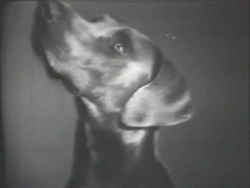William Wegman
Biography
William Wegman has gained international recognition for his work in photography, painting, drawing and video. A postmodern, conceptual humorist, he has been termed a "master of whimsy, whose [works] have a charm and absurdist intelligence sometimes worthy of Beckett," by The New Yorker. Although Wegman is best well known for his witty portraits of his Weimeraner dogs, he is a highly original figure in the history of video art. His comedic, performance-based tapes of the 1970s are among the most enduring of video classics.
Wegman's early video works, many of which star his famous Weimeraner and alter ego, the late Man Ray, use understated humor, minimalist performance and the immediacy and intimacy of low-tech video to create brilliant moments of idiosyncratic narrative comedy. Recorded as single takes in real time, performed in front of a static camera, his tapes document absurdist anecdotes, droll monologues and surreal sight gags. With subversive wit, Wegman ingeniously employs minimal props, his own body and everyday situations as comedic material, delivering monologues in a wry deadpan.
The dog Man Ray, a hapless innocent, functions as an unlikely protagonist, a comic foil and "straight man" for Wegman's fictions. Obedient and trusting, Man Ray is a blank slate upon which Wegman projects and transfers an outrageous psychology of human emotions and motivations. In situational one-liners, Man Ray is provoked into conditioned reactions; Wegman then ascribes anecdotal meaning to the dog's behavior, imposing human traits onto this Other. In one of his most engaging works with Man Ray, the dog appears to respond with consternation when Wegman corrects his spelling lesson; in another, two dogs follow the movements of an off-screen object in perfect unison.
The transference of identity from Wegman to Man Ray is central to the tapes' comic tension. Much of the humor derives from the incongruity of what one sees and what one hears, and the meanings assigned to them — the ironic gap between anticipated and actual behavior, expectations and actuality. Many of the works involve sight gags that parody minimalist and body art practices; body parts and other inanimate objects assume human voices. Television monologues are rendered as absurdist confessionals; extended actions end in hopelessly anticlimactic climaxes. Historically significant and extremely influential, these tapes are also genuinely funny.
Since the late 1970s Wegman has received international acclaim for his work in photography, much of which features anecdotal images of Man Ray and his canine successor, Fay Ray. Fay Ray is also the star of Wegman's later video works, which include a series of comic vignettes for television's Sesame Street.
Wegman was born in 1943. He received a B.F.A. in painting from the Massachusetts College of Art and an M.F.A. in painting from the University of Illinois, Urbana. He has received numerous awards, including grants and fellowships from the Guggenheim Foundation, the National Endowment for the Arts, and Creative Artists Public Service (CAPS).
Wegman's photographs have been the subject of several publications, including Man's Best Friend (1982) and William Wegman: Paintings, Drawings, Photographs, Videotapes (1990). His photographs, paintings, drawings and videotapes have been exhibited widely throughout the United States and Europe, in major solo shows at institutions including the Walker Art Center, Minneapolis; Los Angeles County Museum of Art; Holly Solomon Gallery, New York; Kunstmuseum, Lucerne; Centre Georges Pompidou, Paris; Stedelijk Museum, Amsterdam; Kunstverein, Frankfurt; and the Institute of Contemporary Art, London. Wegman's work has also featured in group exhibitions at festivals and institutions including several Documentas, Kassel, Germany; Whitney Museum of American Art Biennial; Kunsthalle Wien, Vienna; San Francisco Museum of Modern Art; Venice Biennale; The Museum of Modern Art, New York; Institute of Contemporary Photography, New York; the Victoria and Albert Museum, London, and Creative Time's Video Art on the Times Square Astrovision in New York. His work was the subject of a 1990-91 traveling retrospective, William Wegman: Paintings, Drawings, Photographs, Videotapes 1970-1990, which originated at the Kunstmuseum, Lucerne. His videotapes have been broadcast in the United States and abroad, and have been shown nationally on The Tonight Show, The David Letterman Show, and Saturday Night Live. Funney/Strange, a retrospective of Wegman's work, was organized by the Addison Gallery of American Art, Phillips Academy, Andover, Massachusetts, in 2006, with a catalogue published by Yale University Press. The retrospective toured to numerous sites, including the Brooklyn Museum of Art and the Wexner Center for the Arts, Columbus, Ohio. Wegman lives in New York.
